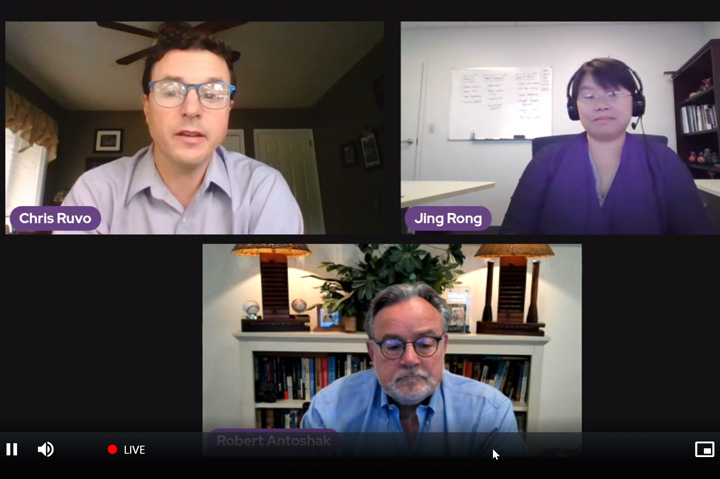News October 14, 2021
Power Summit 2021: Supply Chain Challenges Compel Companies to Rethink Sourcing
In an ASI Power Summit panel discussion, two experts discussed what COVID revealed about the already-fragile supply chain and the path forward.
Thanks to the ongoing supply chain mess, it will soon be too late to receive packages before the end of the year. It’s easy to blame COVID for the headaches, but in actuality, the virus was an accelerant poured on an already-smoldering fire.

ASI Media’s Christopher Ruvo speaks with Jing Rong of HPG and Robert Antoshak of Vidalia Mills about root causes of the current supply chain chaos.
That’s the sentiment from Jing Rong, VP of supply chain & compliance for Top 40 supplier HPG (asi/61966), and Robert Antoshak, senior adviser at Vidalia Mills, who joined ASI Media’s Executive News Director Christopher Ruvo during an ASI Power Summit panel session to discuss the current shipping issues plaguing virtually every industry around the world.
“Some companies are chartering their own vessels,” says Rong. “They’re using different, smaller ports.” It’s gotten so challenging that retail giant Walmart even launched a new “last-mile” delivery service called GoLocal to help facilitate delivery. The Home Depot was the first retail partner of GoLocal, which will provide same-day and next-day delivery of Home Depot products in several states.
At the same time, suppliers have to be more willing to warehouse inventory for longer than usual, says Antoshak. “The just-in-time inventory system is broken,” he says. “The pandemic showed how brittle it was. There’s been a surge in demand, but it takes time to restart the industry. It’s like starting a cold engine.”
Rong looked at recent data from the Port of Long Beach, the country’s second-busiest container port after Los Angeles, and found that the number of arriving imports had increased by 15% between August 2019 and August of this year. That’s causing congestion and a lack of hands to unload ships.
In addition, suppliers in Asia normally work overtime in the summer to meet Q4 demand. Because of COVID, that didn’t happen this year. China, the promo industry’s number-one origin point of goods, has also experienced power outages because of a domestic surge in demand, as well as tension between electricity companies and the Chinese government (along with historic flooding that recently hit the country’s largest coal producer). That complex situation is also contributing to inventory uncertainty, says Rong.
Now, our own @ChrisR_ASI with Jing Rong @hpgbrands and Robert Antoshak of Vidalia Mills about supply chain, inventory and shipping woes #ASIPowerSummit pic.twitter.com/4w5Tq5j3uu
— Sara Lavenduski 🦥 (@SaraLav_ASI) October 13, 2021
In addition, the supply chain is simply too lengthy. Antoshak says a single T-shirt or pair of jeans can travel through four or five countries before it finally reaches the U.S. “There needs to be a focus on regionalization,” he says. “Companies are looking to source closer to the consuming market. It’s not necessarily in-country, which for the U.S. is rare, but at least in the same hemisphere. We need to shorten the supply chain.”
To that end, both Rong and Antoshak call for a renewed and serious focus on diversification. It’s no longer enough to have just a couple sources of supply. “Companies are going to have to look for smaller ports and different modes of transportation,” says Antoshak. “Textile operations are scouring the countryside right now, diversifying away from the largest suppliers.”
For too long, the promo industry has relied heavily on China. That has to change, and COVID has shown why. “We have to diversify the supply chain,” says Rong. “Promo may be able to use Walmart’s [GoLocal] shipping line.”
“Companies are going to have to look for smaller ports and different modes of transportation. Textile operations are scouring the countryside right now, diversifying away from the largest suppliers.” Robert Antoshak, Vidalia Mills
As for an improvement timeline, it’s hard to forecast. Rong is looking at the summer of 2022 or even Q4 of next year. She’s also monitoring COVID cluster outbreaks in China and the upcoming Chinese New Year in Q1. “There are just too many uncertainties right now,” she says.
Meanwhile, Antoshak agrees with Rong’s approximate 12-month prediction and continues to watch inflation rates. “If it jumps, we’ll have the opposite problem,” he says. “Too much supply, not enough demand.”
COVID isn’t the sole cause of the situation; it just showed the vulnerabilities, says Antoshak. Now, companies are being forced to rethink how they procure goods. “The standard ways of doing business have to change,” he says. “The sourcing community has to get creative for the long-haul. They’ll have to unlearn what they learned about sourcing. They’re going to have to take a more practical approach moving forward.”
